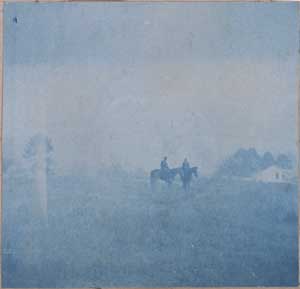| Back
to The Calhoun Industrial School Exhibit

Sir John Herschel (1792-1871)
was the first scientist to publish a description of the cyanotype
process. In addition to being well-known as a astronomer, Herschel
is also credited with the discovery of sodium thiosulphate as
a means of fixing a photographic image on paper and preventing
it from fading.
Herschel's wrote the following
in his notebook now housed in the Science Museum, London:
Jan. 29 [1839]. Experiments
tried within the last few days since hearing of Daguerre's secret
and that Fox Talbot has also got something of the same kind...
Three requisites: (1) Very susceptible paper; (2) Very perfect
camera; (3) Means of arresting the further action.
Tried hypsulphite of soda to
arrest action of light by washing away all of the chloride of
silver or other silvering salt. Succeeds perfectly. Papers 1/2
acted on 1/2 guarded from light by covering with pasteboard,
were when withdrawn from sunlight, then well washed in pure
water - dried, and again exposed. The darkened half remained
dark, the white half white, after any exposure, as if they had
been painted in speia... Thus Daguerre's problem is so far solved.
Almost all photographic processes
rely on Herschel's discovery. It was also Herschel who suggested
the name "photography" instead of the previously used
"photogenic drawing."
Cyanotype was the first photographic
process to be used to illustrate a book. The first woman photographer,
Anna Atkins, used cyanotypes to illustrate her book, Cyanotypes
of British and Foreign Flowering Plants and Ferns. This was
also the first book of printed photographs and text.
 |
Sodium thiosulphate is
erroneously known as sodium hyposulphite or hypo and was
crucial to the development of photography and is still used
in certain photographic techniques today. This method uses
two simple compounds of iron to make light sensitive material.
The print that results from this chemical is cyan blue in
color, thus giving the process its name.
|
Cyanotypes use ultra-violet light
or sunlight to expose the image.A chemical mixture is used to
coat the paper and allowed to dry. An object or image is then
exposed on the paper in sunlight. The paper is washed under cool
running water and allowed to dry. The blue color ranges from pale
to deep blue tones.
Herschel is also known for his
development of the blueprint, a method for copying architectural
drawings. Like cyanotypes, blueprint paper begins white and is
then coated with light-sensitive chemicals. A translucent sheet
on which the architectural diagrams have been drawn is placed
over the paper; a strong light is then directed through the translucent
sheet onto the paper. Those portions of the paper exposed to the
light become blue when washed in water, while areas protected
from light by the drawing's lines do not. The result is a white-line
print on blue paper.
|